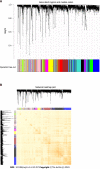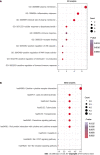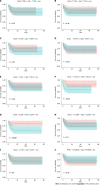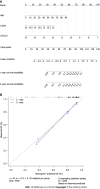Hub genes and their key effects on prognosis of Burkitt lymphoma
- PMID: 37970111
- PMCID: PMC10631346
- DOI: 10.5306/wjco.v14.i10.357
Hub genes and their key effects on prognosis of Burkitt lymphoma
Abstract
Background: Burkitt lymphoma (BL) is an exceptionally aggressive malignant neoplasm that arises from either the germinal center or post-germinal center B cells. Patients with BL often present with rapid tumor growth and require high-intensity multi-drug therapy combined with adequate intrathecal chemotherapy prophylaxis, however, a standard treatment program for BL has not yet been established. It is important to identify biomarkers for predicting the prognosis of BLs and discriminating patients who might benefit from the therapy. Microarray data and sequencing information from public databases could offer opportunities for the discovery of new diagnostic or therapeutic targets.
Aim: To identify hub genes and perform gene ontology (GO) and survival analysis in BL.
Methods: Gene expression profiles and clinical traits of BL patients were collected from the Gene Expression Omnibus database. Weighted gene co-expression network analysis (WGCNA) was applied to construct gene co-expression modules, and the cytoHubba tool was used to find the hub genes. Then, the hub genes were analyzed using GO and Kyoto Encyclopedia of Genes and Genomes analysis. Additionally, a Protein-Protein Interaction network and a Genetic Interaction network were constructed. Prognostic candidate genes were identified through overall survival analysis. Finally, a nomogram was established to assess the predictive value of hub genes, and drug-gene interactions were also constructed.
Results: In this study, we obtained 8 modules through WGCNA analysis, and there was a significant correlation between the yellow module and age. Then we identified 10 hub genes (SRC, TLR4, CD40, STAT3, SELL, CXCL10, IL2RA, IL10RA, CCR7 and FCGR2B) by cytoHubba tool. Within these hubs, two genes were found to be associated with OS (CXCL10, P = 0.029 and IL2RA, P = 0.0066) by survival analysis. Additionally, we combined these two hub genes and age to build a nomogram. Moreover, the drugs related to IL2RA and CXCL10 might have a potential therapeutic role in relapsed and refractory BL.
Conclusion: From WGCNA and survival analysis, we identified CXCL10 and IL2RA that might be prognostic markers for BL.
Keywords: Burkitt lymphoma; Functional enrichment analysis; Microarray data; Prognosis; Therapeutic target; Weighted gene co-expression network analysis.
©The Author(s) 2023. Published by Baishideng Publishing Group Inc. All rights reserved.
Conflict of interest statement
Conflict-of-interest statement: All authors declare that they have no conflicts of interest and have never published the manuscript.
Figures









Similar articles
-
Identification of key gene modules and hub genes of human mantle cell lymphoma by coexpression network analysis.PeerJ. 2020 Mar 20;8:e8843. doi: 10.7717/peerj.8843. eCollection 2020. PeerJ. 2020. PMID: 32219041 Free PMC article.
-
Identification of Effective Diagnostic Biomarkers and Immune Cell Infiltration in Atopic Dermatitis by Comprehensive Bioinformatics Analysis.Front Mol Biosci. 2022 Jul 14;9:917077. doi: 10.3389/fmolb.2022.917077. eCollection 2022. Front Mol Biosci. 2022. PMID: 35911963 Free PMC article.
-
Identification of susceptibility modules and hub genes of osteoarthritis by WGCNA analysis.Front Genet. 2022 Nov 18;13:1036156. doi: 10.3389/fgene.2022.1036156. eCollection 2022. Front Genet. 2022. PMID: 36468029 Free PMC article.
-
Weighted gene co-expression identification of CDKN1A as a hub inflammation gene following cardiopulmonary bypass in children with congenital heart disease.Front Surg. 2022 Aug 24;9:963850. doi: 10.3389/fsurg.2022.963850. eCollection 2022. Front Surg. 2022. PMID: 36090322 Free PMC article.
-
Common gene signatures and key pathways in hypopharyngeal and esophageal squamous cell carcinoma: Evidence from bioinformatic analysis.Medicine (Baltimore). 2020 Oct 16;99(42):e22434. doi: 10.1097/MD.0000000000022434. Medicine (Baltimore). 2020. PMID: 33080677 Free PMC article.
References
-
- Bishop PC, Rao VK, Wilson WH. Burkitt's lymphoma: molecular pathogenesis and treatment. Cancer Invest. 2000;18:574–583. - PubMed
-
- Sall FB, Shmakova A, Karpukhina A, Tsfasman T, Lomov N, Canoy RJ, Boutboul D, Oksenhendler E, Toure AO, Lipinski M, Wiels J, Germini D, Vassetzky Y. Epstein-Barr virus reactivation induces MYC-IGH spatial proximity and t(8;14) in B cells. J Med Virol. 2023;95:e28633. - PubMed
-
- Magrath I. Epidemiology: clues to the pathogenesis of Burkitt lymphoma. Br J Haematol. 2012;156:744–756. - PubMed
-
- Sant M, Allemani C, Tereanu C, De Angelis R, Capocaccia R, Visser O, Marcos-Gragera R, Maynadié M, Simonetti A, Lutz JM, Berrino F HAEMACARE Working Group. Incidence of hematologic malignancies in Europe by morphologic subtype: results of the HAEMACARE project. Blood. 2010;116:3724–3734. - PubMed
LinkOut - more resources
Full Text Sources
Research Materials
Miscellaneous

